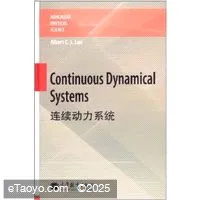
《连续动力系统(英文版)》极具创新特色,首次揭示了混沌不只是可以通过数字模拟实现,而目可以用解析形式来表示。书中提出了关于连续动力系统的稳定性和分叉理论的一种新的、清晰简明的观点,能够帮助读者更好地理解动力系统中的规则性和复杂性。《连续动力系统(英文版)》首先介绍了含多重特征根的线性连续系统的解析解和稳定性理论,并详细讨论了非线性连续动力系统的稳定性和奇异性分类,然后系统地讨论动力系统从周期解到混沌的解析道路。此外《连续动力系统(英文版)》还讨论了动力系统流对于同宿或异宿轨道分界面的全局横截性的解析预测并且给出了非线性哈密顿系统混沌的解析判据,从而能更好地确定混沌在非线性动力系统中的物理机理。
编辑推荐
《连续动力系统(英文版)》可作为应用数学、物理、力学和控制专业大学生的教材或参考,也可供这些领域的教授和研究人员参考。 目录
Preface
Chapter 1 Linear Systems and Stability
1.1 Linear systems with distinct eigenvalues
1.2 Operator exponentials
1.3 Linear systems with repeated eigenvalues
1.4 Nonhomogeneous linear systems
1.5 Linear systems with periodic coefficients
1.6 Stability and boundary
1.7 Lower-dimensional linear systems
1.7.1 One-dimensional linear systems
1.7.2 Planar linear systems
1.7.3 Three-dimensional linear systems
References
Chapter 2 Stability Switching and Bifurcation
2.1 Continuous dynamical systems
2.2 Equilibriums and stability
2.3 Bifurcation and stability switching
2.3.1 Stability and switching
2.3.2 Bifurcations
2.3.3 Lyapunov functions and stability
References
Chapter 3 Analytical Periodic Flows and Chaos
3.1 Analytical periodic flows
3.1.1 Autonomous nonlinear systems
3.1.2 Periodically forced nonlinear systems
3.2 Nonlinear vibration systems
3.2.1 Free vibration systems
3.2.2 Periodically forced vibration systems
3.3 A periodically forced Duffing oscillator
References
Chapter 4 Global Transversality and Chaos
4.1 Nonlinear dynamical systems
4.2 Local and global flows
4.3 Global transversality
4.4 Global tangency
4.5 Perturbed Hamiltonian systems
4.6 Two-dimensional Hamiltonian systems
4.7 First integral quantity increment
4.8 A damped Duffing oscillator
4.8.1 Conditions for global transversality and tangency
4.8.2 Poincare mapping and mapping structures
4.8.3 Bifurcation scenario
4.8.4 Numerical illustrations
References
Chapter 5 Resonance and Hamiltonian Chaos
5.1 Stochastic layers
5.1.1 Definitions
5.1.2 Approximate criteria
5.2 Resonant separatrix layers
5.2.1 Layer dynamics
5.2.2 Approximate criteria
5.3 A periodically forced Duffing oscillator
5.3.1 Approximate predictions
5.3.2 Numerical illustrations
5.4 Concluding remarks
References
Index 文摘
版权页:
插图:
For a global view of stability of the approximate solutions (HB2), the corre- sponding parameter map is presented in Fig.3.2. The regions of single stable peri- odic motion are shaded by gray color, which is labeled by "S". The regions of single unstable periodic motion are hatched, which is labeled by "U". The regions of three periodic motions are divided into three portions. The portions with two stable solutions and one unstable solution are labeled by "SSU" (red). The por- tions with one stable solution and two unstable solutions are labeled by "SUU" (blue), and the portions with three unstable solutions are labeled by "UUU" (yel- low). This parameter map gives a better understanding of dynamical behaviors of periodic solution based on the two harmonic terms. Some region in parameter map in Fig.3.2(a) is not clear. Thus, the zoomed parameter map should be presented in order to show the dynamical behavior, as shown in Fig.3.2(b) and (c). Similarly, for approximate solution with other higher order harmonic terms, the parameter maps can be developed. Herein, the parameter map based on HB2 is as an exam- ple to show how to develop the parameter maps. For the exact periodic motion, infinite terms should be included. To make sure how many harmonic terms can provide an analytical solution to approximate the exact solution. Comparison of approximate solutions with a few harmonic terms was presented in Luo and Huang (2011).
(B) Period-m Motions. Once the Hopf bifurcation of periodic motion occurs, there is a new periodic motion of period-m motion. For the period-1 motion with pa- rameters in Eq.(3.122), the Hopf bifurcation occur at Ω = 4.182 and 6.197. The onset of the period-2 motion at Ω = 4.182 and 6.197 occurs. Thus, the analytical solutions of period-2 motion can be obtained, and the corresponding stability and bifurcation analysis can be done. Consider the same parameters in Eq.(3.122) to discuss period-2 motion. The results of harmonic amplitudes are presented in Fig.3.3(a)-(i) with eight harmonic terms (HB8) to approximate period-2 motions.
| ISBN | 7040348195,978704034 |
|---|---|
| 出版社 | 高等教育出版社 |
| 尺寸 | 16 |